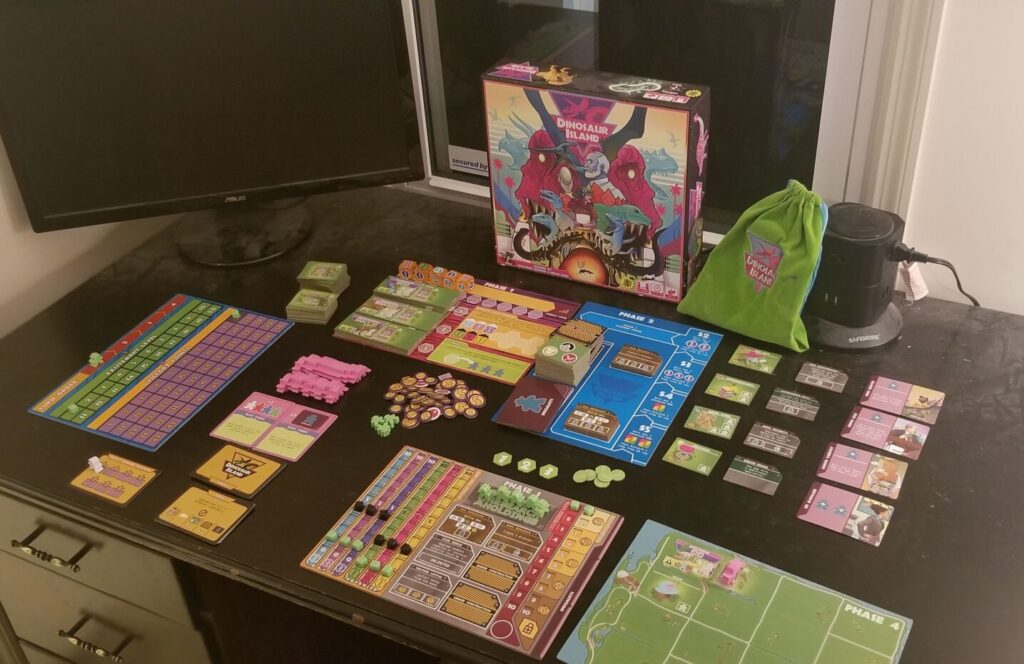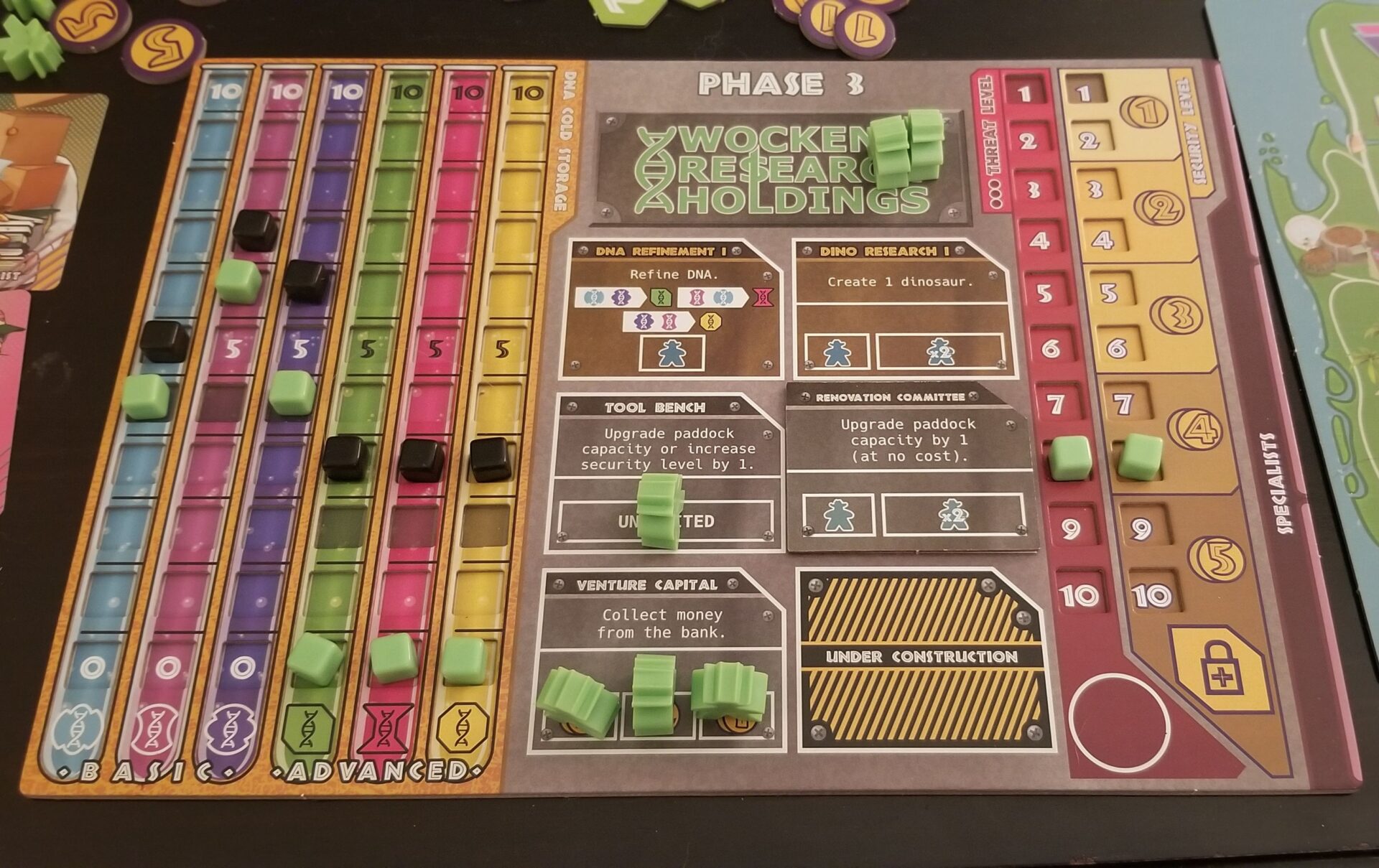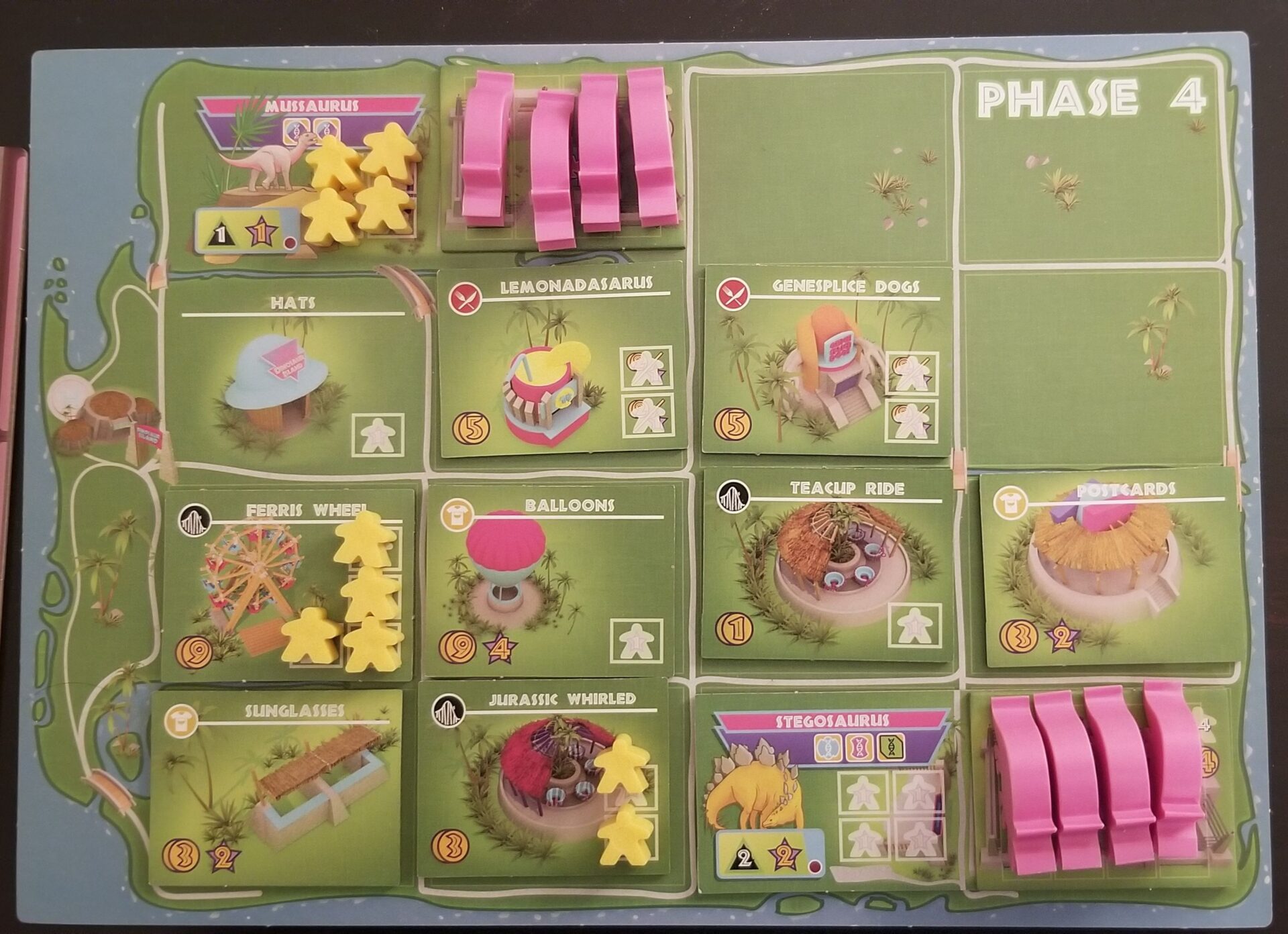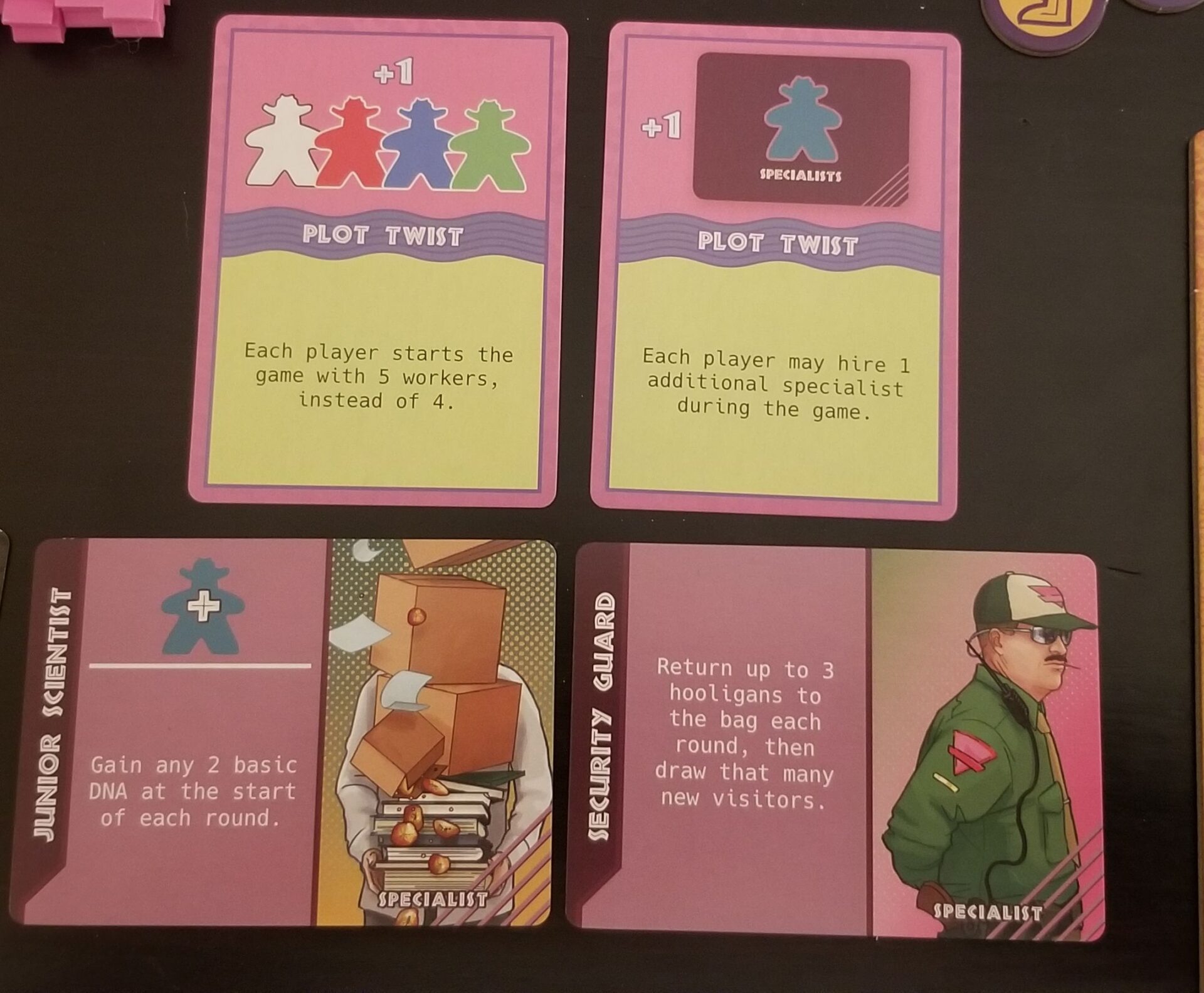
Name: Dinosaur Island
Year of Release: 2017
Player Count: 1 – 4 Players
Playing Time: 90 – 120 minutes
Designer: Jonathan Gilmour, Brian Lewis
Publisher: Pandasaurus Games
Primary Mechanisms: Dice Rolling, Set Collection, Worker Placement
Weight (According to boardgamegeek.com): 3.03
Overview
For this review, I’ve decided to break out Pandasaurus Games’ dino-creating, attraction-building, and patron-eating epic, Dinosaur Island. My wife and I have owned this game for probably two or three years and while we’ve played it 2-player quite a few times, I’ve never brought it to the table for the official solo variant. Let’s see how it fairs on a 1-player basis.
Artwork, Components, and Setup

If you’ve ever played Dinosaur Island (or even seen pictures of it), you probably had some type of gut-reaction to the graphic design decisions that were made. To say the color scheme is “loud” is probably an understatement but to me, it works. The aesthetics all scream “over-the-top 80’s movie”, giving the theme more of a B-rated comedy air than a Jurassic Park thriller vibe. Unfortunately, I feel that these bold design choices probably turn more people off than on, possibly causing players to never give this game the chance it deserves.
The game takes up a T-rex sized footprint on your table, even if you’re playing solo. There are boards galore to set out, a market of cardboard tiles and cards to seed, and meeples and chits all over the place. For the most part, I’m happy with the components. The DNA die are heavy and even have that amber shade to them that you might recall from Jurassic Park (where the mosquito was stuck, thus allowing them to extract the dino-DNA.) Your worker meeples have little hats on, distinguishing them as the badasses that are there to keep the dinosaurs in line. Your personal lab board even has cutouts for the DNA markers to sit in which is a lovely addition that improves the quality of life when playing the game.
On the downside, I think Pandasaurus missed a huge chance when they only supplied players with one type of dinosaur meeple. Not sure why they would think that this would be more fun than choosing between a few different meeples to populate your park with. The scientist chits are also lack-luster, solely printed in the player color with a 1, 2, or 3 on it. If we have worker meeples, why not scientist meeples? It’s not a huge deal, but just another way the design choices are a little inconsistent.
Lastly, the setup to this game is probably my least favorite part. It’s hindered by the fact that the insert is horrible and helps in no way to keep this game organized. You have to remove tiles depending on player count and when I open the box, I just feel like I’m staring at a mess that I have to root through before the fun can ever start. I actually like how the game is set up: players having their individual lab and park boards, players sharing a nicely organized market that changes after each round, and a central Phase 1 board where players assign their scientists to do their scientist-y tasks. The setup itself makes each phase clear and gives plenty of instruction on how to move from one phase to the next, it’s just the act of setting the game up that irks me.
Gameplay

A round in Dinosaur Island works in phases.
- Phase 1 is dedicated to placing your three scientists (numbered 1, 2, and 3) onto the phase 1 board in order to do a few different things. You can collect DNA from the dice roll that starts each round, in order to create dinosaurs in a later phase. You can draw new dinosaur tiles that will be immediately placed into your park, allowing for a new breed of dinosaur to be created. Lastly, you can use your scientists to increase the storage capacity of the 6 DNA types. If none of these options strike your fancy, you can also convert scientists into workers to be used in phase 3.
- Phase 2 is when you hit the market. The market is made up of four levels, ranging from $2 to $5 in cost. Each level consists of an attraction tile, a lab upgrade tile, and a specialist card. You can buy two of these objects, or pay a cost to harvest more DNA, or even pass and collect $2.
- Phase 3 takes place solely on your personal lab board. You will use your available workers in standard worker placement style, taking different actions in your lab to further enhance your park. These actions typically help you create more dinosaurs, expand paddocks, increase security, or gain money. The lab upgrades in phase 2 can be placed in your lab to give an even larger assortment of actions for your workers.
- Phase 4 is when your park opens up for the day and the fun (or the chomping) begins. As you create dinosaurs, the excitement level of your park will increase, causing you to draw more visitors from the bag. These visitors can either be yellow-colored patrons or pink colored hooligans. The patrons will score you a $1 for each one that enters your park, but the hooligans don’t pay, instead breaking the line and generally causing mischief. You then place the visitors into their slots in your park, hopefully having enough tiles to accommodate the visitors you’ve pulled from the bag. If not, you still earn the $1 but you won’t score any VPs as there won’t be capacity for them to have fun in the park. Lastly, you check your security level vs. the threat level generated by the dinosaurs you’ve created, if they don’t match up, some people are about to get eaten. You score VPs for any visitors remaining after the dinosaur feeding fiasco and then move to phase 5.
- The last phase is dedicated to checking to see if any objectives have been met and cleaning up and re-seeding the market for the next round.
The solo variant gameplay of Dinosaur Island is overall positive with only a few minor drawbacks. The biggest positive is how the solo objective cards are implemented. Each card you flip over at the beginning of the round, tells you which die, dino tiles, and/or market cards to remove from the round. This feels like a fairly accurate portrayal of playing against another human since you are both vying for the same resources in phases 1 and 2. These same cards (except a different selection of them) forms a pool of objectives that you are trying to reach throughout the game. I much prefer this objective style to the way the multiplayer version is implemented. Every time you meet an objective, you score points based on the round you completed it in. So, the more objectives you score earlier in the game, the larger number of points it scores you. Conversely, if there is a round you fail to meet an objective, you have to discard one card, causing your overall objective pool to decrease. I was really impressed with how much this adds to the solo game.
The thing I least like about the solo variant is it is just another one of those solo games where you’re competing to see what the highest score you can get is. The instruction manual doesn’t even print any sort of chart to help detail if you’ve done a nice job or not. I much prefer solo games that somehow simulate the AI player scoring points, but I understand that this game does have a lot going on and the designers could have run into balance problems. The same can be said for the dinosaur tiles (which is not just a solo variant problem.) Basically, all dinosaurs of each category are the same. There is literally no reason I would ever buy a small carnivore. But from the reading I’ve done, the design team tested out making the dinosaurs more unique, but this too caused balance problems. And hey, they’re the game makers, not me, so I’m sure they know better than me!
Conclusion

I’m glad I decided to try the solo game out. I actually liked it so much, it inspired my wife and I to play the multiplayer version the next day and we both had a blast again. If it weren’t for the long setup time, I’d probably get this to the table even more. I don’t own the Totally Liquid expansion but if you have and you have any opinions on if it’s worth getting (especially for a solo gamer) please chime in down in the comments!
Rating
Ratings are based on 5 main criteria: rulebook, setup, components, art & graphic design, and gameplay. The first 4 criteria are rated 1 to 5 and the gameplay is rated 1 to 10. These scores culminate in an “overall satisfaction” score that is rated from 1 to 10. If the reviewed game has both a solo and multiplayer mode, I have assigned scores separately to give context to which mode we enjoy more.
Links
As an Amazon Associate I earn from qualifying purchases.
Amazon: Dinosaur Island Board Game
